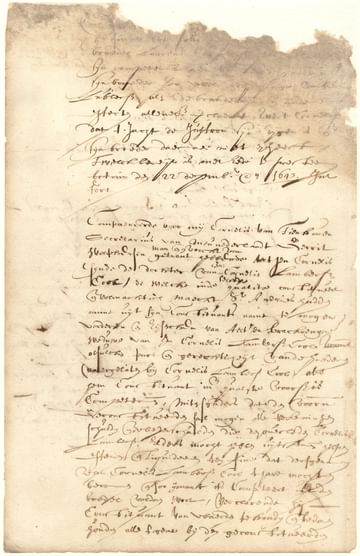 by Lori Ashley
by Lori AshleyLand records are permanent. What is your e‑records preservation strategy?
Preservica Lori Ashley discusses the the recording and preservation of land and real property and the transition to heavy reliance on electronic records and technologies.
Recording and preservation of land and real property is a foundational statutory and administrative operation of government. The attraction of land and settlement opportunities in the United States and Canada make property among the earliest, largest, and most complete type of records under management in North America.
When I stopped for a visit at the New York State Archives on my way to the NAGARA Regional Forum in early November, Thomas Ruller, the Assistant Commissioner for Archives and State Archivist, graciously showed me paper records from the mid-1600’s which relate to the Dutch colony of New Netherland. New Netherland was one of the earliest European settlements that became the states of New York, New Jersey, Pennsylvania, and Delaware. Nearly 7,000 documents in the Dutch collection have been digitized and translated and are available online to researchers, educators and genealogists.

Record from New York State Archives - New Netherland Provincial Secretary register of the Provincial Secretary collection
As public sector agencies and institutions around the world transition to heavy reliance on electronic records and technologies, the custodians of real property records and indexes – Registers of Deeds, Clerks, Assessors, Recorders, Records Managers, and Archivists – need to incorporate proven digital preservation solutions and techniques to their existing information governance, records management and historical archiving practices in order to protect and provide access to these records forever. The volume, diversity and longevity of land records, including maps, recorded instruments and indexes, offers a powerful business case for enterprise-scale digital records preservation capabilities for government in order to fulfill public records laws and historical interests.
This post explores ways to leverage the use case for the continuity of land and property records to engage and educate key stakeholders about evolving practices in electronic records preservation. And while vital records – birth, death, marriage and service records – provide an equally compelling case for adopting best practices in electronic records preservation, I’ll leave the discussion on those high value, high risk collections for another post.
Evolution and Integration of Disciplines
Government authorities have been recording, capturing and storing permanent records using electronic information systems and techniques for more than half a century. As detailed in the Property Records Industry Association Electronic Records Preservation Education Module the 20th century added new technologies and techniques to paper and film preservation that included photostat copies, microfilm, and electronic imaging.
Electronic imaging delivers operational benefits over paper and film records that include reduced physical storage demands as well as faster search and improved access. Digitization services abound in the public sector and the resulting images and their metadata can be readily managed by dedicated land management systems or by any number of content and records management technologies. It has been common practice for many decades to save digital surrogates in preferred technology-neutral file formats like JPG, TIFF and PDF. But unlike their analog counterparts, electronic records are “machine readable,” requiring a complex of hardware and software to access and render them whether for internal, private or public use. Digital content is fragile and subject to loss, corruption, breach and obsolescence. Three-to-five-year technology refresh and replacement cycles keeps electronic records management a moving target.
Permanent records that describe and protect property rights have special significance and enduring value. As a result, the government has the responsibility to record and to keep these records legible and authentic regardless of means or method of preservation without any timeframe limitations.
The exponential increase in electronic government records (an 82% increase from FY2016 per the 2019 edition of CoSA’s statistical report on US state archives and records management programs) underscores the critical need for capabilities and resources to ensure the long-term stability of permanent records collections.
Electronic Records Preservation
Each recording jurisdiction records private property documents but also maintains a wide variety of records that pertain to land and buildings owned and maintained by the government itself. Depending on the geographic characteristics and scope of authority that the jurisdiction has, records relating to parks and roads, easements, bridges, airports, utilities, medical and jail facilities, courthouses and historical buildings will be under long-term management.
In PRIA’s 2018 Electronic Records Preservation paper the four vital components of an effective electronic records preservation program were identified as:
- The ability at any time to confirm the existence of a record,
- The ability to authenticate the record,
- The ability to maintain file uniformity or track acceptable file formats, and
- The ability to recover the authentic record if it has been lost or corrupted
Safely keeping, preserving, and maintaining, all these recorded objects and the indices needed to find and retrieve them is a complex and on-going enterprise obligation. Thus, the business case for resources and technical capabilities and infrastructure to actively preserve permanent electronic records throughout their lifetimes is mandated for both internal and external reasons.
Duty to Preserve
The recording and preservation of real property records is explicitly mandated at federal, state and local levels of government. A Register of Deeds in 2020 must be able to find, retrieve and produce authentic records from the beginning of her/his county’s incorporation. The local Archives or Historical Society most likely has custody of thousands of records that document the settlement of the area and the demographic trends and milestones since.
Purpose-built, digital preservation tools and solutions effectively safeguard and future-proof permanent electronic government records and metadata to ensure access and retrieval far into the future. And they can actively migrate collections at scale to newer formats over time. These rich metadata environments not only leverage traditional finding aids but are able to integrate with other catalogs and indices to support access to a continuous record of land ownership and development.
For agencies that currently use a Land Records Search (LRS) system, transfers to a preservation environment can be potentially seamless and automated, leveraging the strengths of both systems to working in a complementary fashion.
Because most land and real property records are “born permanent,” I believe there are significant opportunities to selectively integrate active digital preservation capabilities with records repositories across the enterprise and streamline operations.
- Analyze retention schedules to identify permanent records classes and repositories
- Identify which file formats departments are using to store long-term and permanent records
- Map permanent records managed exclusively in electronically encoded formats to their respective system of records
- Work with IT to identify transfer protocols to move electronic records to active preservation environments as needed
Additional ways to strengthen the enterprise business case for automated and scalable digital preservation capabilities include:
- Complete a digital preservation capability maturity assessment for a select set of priority systems of record and use to highlight gaps and educate stakeholders on requirements
- Review the IT project portfolio for systems being replaced, upgraded, implemented or configured and flag if they manage permanent records
- Establish a peer working group to learn about digital preservation ‘good practices’ and how they apply to your agency and jurisdiction
I hope this post provides some useful information to advance your digital land records preservation strategy. If you are interested in additional resources, please feel free to contact me.
